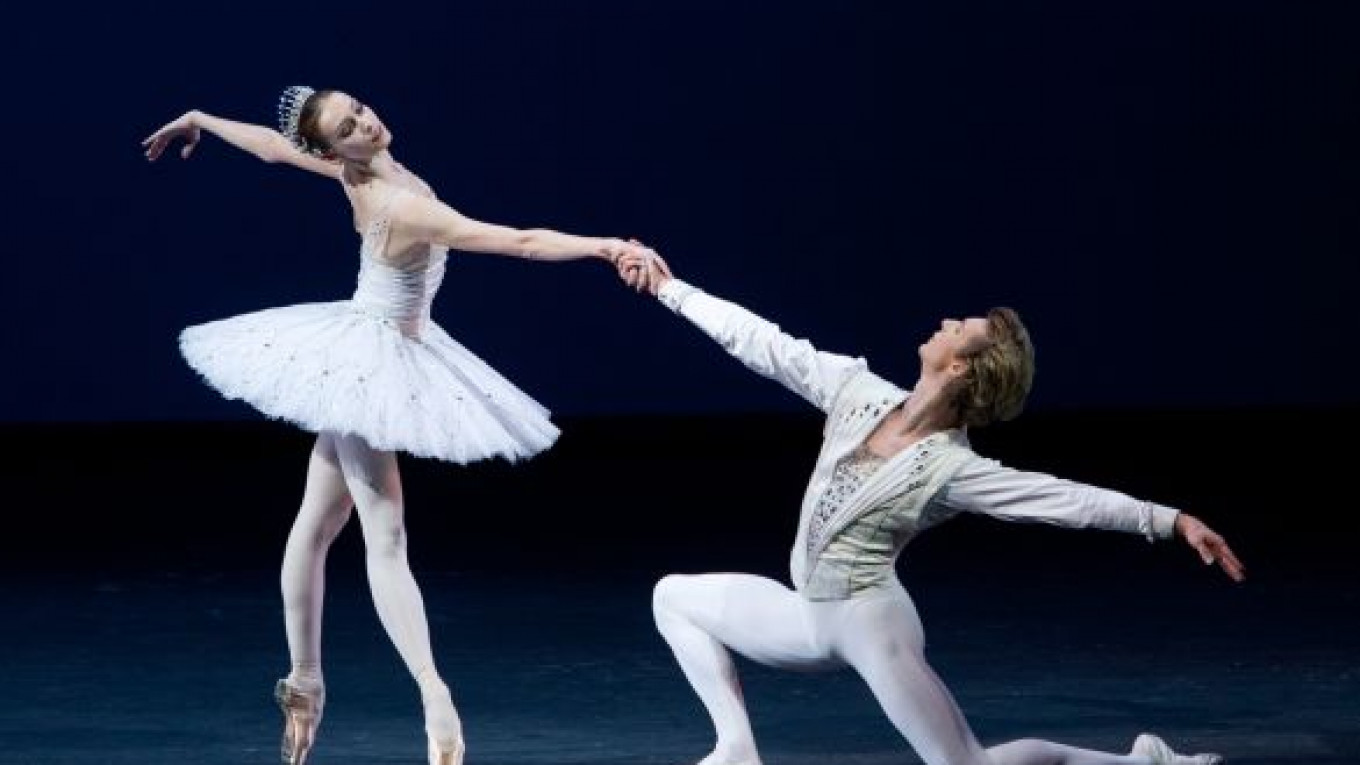No dance troupe in the world, even today's New York City Ballet, the company which George Balanchine founded in 1946 and led until his death 39 years later, is likely to do real justice to all three of the diversely styled ballets that the choreographer collectively titled "Jewels."
The Bolshoi Theater, which presented "Jewels" for the very first time over the May holidays, proved no exception. To its credit, however, it did manage to achieve quite respectable results in two of the work's three segments.
It came as no surprise to find the Bolshoi dancers comfortably at home in "Diamonds," the "Russian" finale to "Jewels," set to the music of Pyotr Tchaikovsky and fashioned by Balanchine with more than a nod toward the choreography of the Mariinsky Theater's great Marius Petipa, on which he was nurtured during his youthful years in St. Petersburg.
What did surprise in "Diamonds," or nearly so, was the dancing of lead female Olga Smirnova, a 19-year-old alumna of St. Petersburg's Vaganova Academy, the top graduates of which normally find themselves snapped up by the Mariinsky. Luckily, the Bolshoi got her instead.
I was alerted beforehand to Smirnova's extraordinary talent by Sandra Jennings and Paul Boos, two of the three former New York City Ballet soloists responsible for staging "Jewels." "She's truly amazing," Jennings told me. "Like a ballerina from somewhere out of the past," Boos added. The reality, as seen at a dress rehearsal and two performances, was dancing of almost indescribable beauty, harmonious throughout and near-perfect in technique. At times, she actually brought to mind what I recall from the magical performance of the role's first exponent, Suzanne Farrell.
For all its fine female soloists, the Bolshoi has no other who seems quite such a perfect match for the leading roles in its trio of Tchaikovsky ballets — "Swan Lake," "Sleeping Beauty" and "The Nutcracker." And, with time, there should be much else in the theater's repertoire, both classical and modern, to display Smirnova's remarkable gifts.
The Bolshoi caught the subtleties of "Emeralds," the elusive, French-flavored opening segment of "Jewels," with nearly as much skill. Yevgenia Obraztsova, another Vaganova graduate, recently acquired from the Mariinsky, and Anna Tikhomirova gave accomplished and nicely contrasted performances in the two leading roles on opening night.
But in "Rubies," the "American" segment of "Jewels," the Bolshoi almost totally failed to convince. Lacking most of all was the right sort of dancer for the principal female role, one with an easy grasp of the jazzy, syncopated rhythms in Igor Stravinsky's score, enormous energy and a sparkling stage presence. Fine ballerina though she is, Yekaterina Krysanova gave little more than a dutifully correct performance on opening night, displaying practically nothing of charm or temperament.
For its production of "Jewels," the Bolshoi took the bold, but, as it turned out, misguided step of creating entirely new scenery and costumes.
Balanchine was very particular about the costuming and stage decoration of his ballets, and probably never more so than in the case of "Jewels." The choreographer might have given at least grudging approval to Yelena Zaytseva's costumes for the Bolshoi, which remained reasonably close in form and spirit to those of Barbara Karinska for the original 1967 New York production. But he almost certainly would have been appalled by Alyona Pikalova's sets for "Emeralds" and "Rubies." (For technical reasons, her set for "Diamonds" was replaced at the opening performances by a harmless blue backcloth with a wash of tiny, multicolored stars across its midsection.)
The sets for both "Emeralds" and "Rubies" consist of columns, reaching from bottom to top of the stage and constructed out of what look to be translucent glass blocks, lighted in green for "Emeralds" and, at twice the width, in red for "Rubies." Separating the columns are grayish panels, decorated with thin, vertical reflective strips.
It may be something of an overstatement to describe Pikalova's decor as reminiscent of a public lavatory, as did two eminent Moscow ballet critics within my range of hearing on opening night. For my own part, I would simply call the decor hopelessly banal and at odds with the essence of both ballets.
Balanchine demanded atmosphere for "Emeralds," even to the point of seeking, without success, to have the very air on stage colored green. Though the columns in "Emeralds" appeared quite impressive when the curtain opened at the Bolshoi, it quickly became clear that, far from providing atmosphere, they served as nothing more than a tiresome distraction. In the case of "Rubies," the glare of the columns seemed constantly at war with the red upper parts of the dancers' costumes and the carefree spirit of the choreography.
"Jewels" is not due to be seen again at the Bolshoi until after the opening of next season in September.
A Message from The Moscow Times:
Dear readers,
We are facing unprecedented challenges. Russia's Prosecutor General's Office has designated The Moscow Times as an "undesirable" organization, criminalizing our work and putting our staff at risk of prosecution. This follows our earlier unjust labeling as a "foreign agent."
These actions are direct attempts to silence independent journalism in Russia. The authorities claim our work "discredits the decisions of the Russian leadership." We see things differently: we strive to provide accurate, unbiased reporting on Russia.
We, the journalists of The Moscow Times, refuse to be silenced. But to continue our work, we need your help.
Your support, no matter how small, makes a world of difference. If you can, please support us monthly starting from just $2. It's quick to set up, and every contribution makes a significant impact.
By supporting The Moscow Times, you're defending open, independent journalism in the face of repression. Thank you for standing with us.
Remind me later.






